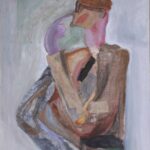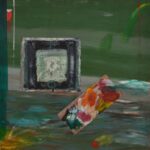
Katinas Linas Leonas
Born on June 22, 1941 in Radviliškis.
Son of artist Leonas Katinas. Graduated from the Lithuanian Institute of Arts (architecture) in 1964. Since 1967, he has participated in exhibitions; individual ones in Vilnius (1967, 1968, 1974, 1984, 1986, 1988, 1990, 1993, 1996), Tallinn (1973), Charlottesville (Virginia, 1974), art projects in Lithuania and abroad. Member of the group “24” (since 1990). Member of the Lithuanian Artists’ Union since 1967. In 1968-1992, he taught at the M. K. Čiurlionis Art Gymnasium in Vilnius, and since 1992, he has been teaching at the Vilnius Academy of Arts.
Created paintings, drawings, watercolors, installations. The work of the early 1st period contains features of expressionism (“Jūra” I-IV – 1967, “Arimai” – 1968); experimented with various (collage, etc.) techniques. In the 1970s-1980s, he turned to abstractionism. The works are architectural compositions, they contain cosmogonic symbols, sometimes human silhouette figures, multi-layered glazes, textures are used, and other techniques are combined with painting. The artist’s work reflects his interest in the ornamentation of Lithuanian folk fabrics, and later in Buddhist culture and art, the interaction of Western and Eastern civilizations (“Raigardas”, “Naktis” I-IV, “Laivas” I-III – all 1975, “Kosmograma” – 1981, “Agla” – 1988 (LDM).
In his works of the 1910s – 20th century, there are clear elements of conceptual art, pictograms, hieroglyphs, quotes are often used; he created works on Christian themes (“Nieko nkukrižiavimas, 2001), works related to the work of other artists (“Vincento vinugynas”, 2002). Other works preserved in the LDM: “Still Life with Dolls” (1965, LDM), “Paper Flowers” (1967, LDM), “Atspindys” III (1970, LDM), “Labanoros uzdėlėda” I (1982, LDM), “Nendrė” I (1984, LDM), etc.
Awards
In 1999, he was awarded the Lithuanian National Prize.
Art critics’ insights
The artist draws inspiration from a wide variety of sources – from Tibetan Buddhist art to Lithuanian ethnographic heritage, from nature to everyday life. Katinas’s paintings contain hints of landscapes, plants, flags, carpets, blankets, as well as archetypal signs, sacred objects or even works by other artists, but at the same time all motifs are highly abstracted. Some canvases also contain inscriptions or individual muscular elements.



